#home ownership disparities
Explore tagged Tumblr posts
Text
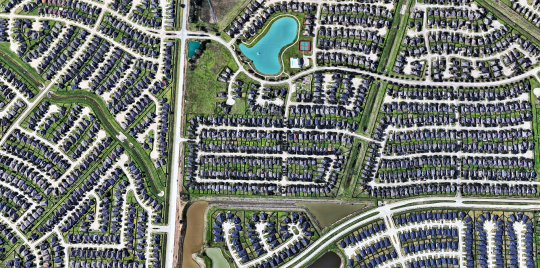
A shocking 70% of the nation’s 1,036 majority-Black ZIP codes are considered “distressed,” while only 19 — 1.8% — rank as “prosperous,” according to one analysis. Two of those prosperous ZIP codes are in Fort Bend County.
If you weren’t familiar with the lengthy list of disparities that exist in America, you’ve likely been brought up to speed by the pandemic, which has provided a frightening crash course in the nation’s inequalities. The large and widening divide between “prosperous” and “distressed” communities since the turn of the century was seen clearly in the quick economic recovery experienced by those with higher-paying jobs and better educations following the Great Recession. Meanwhile, many less fortunate Americans were still struggling to recover when the pandemic hit, bringing with it an even greater recession and hardship. And like the disease itself, the COVID-19 economic downturn has splintered the lives of those who are the least resilient — both physically and economically — while those whose jobs allow them to work from home have remained largely insulated from the virus and financial troubles.
Approximately 50.5 million Americans live in a distressed community. But what exactly does that mean?
Distressed communities are characterized by widespread poverty, high rates of unemployment and low levels of educational attainment. They also face stagnant or negative economic growth, which means little to no change in the prospects of those who live there.
To examine how economic well-being is spread across communities and regions in the U.S., the Economic Innovation Group (EIG) has released its Distressed Communities Index (DCI) each year since 2016.
“Economic inequality in America translates into opportunity gaps for too many communities,” said Steve Glickman, cofounder and executive director of the Economic Innovation Group, when the inaugural index was released. “Unless policymakers in both parties reframe their priorities, economically distressed communities will continue to experience a downward spiral that results in a loss of faith in the American dream and less healthy and fulfilling lives.”
Communities are defined at the ZIP code level and scores range from 0 (most prosperous) to 100 (most distressed). Based on the score, communities were placed into one of five tiers of economic well-being: prosperous, comfortable, mid-tier, at risk and distressed.
The seven metrics used to calculate a community’s score on the index were no high school diploma, housing vacancy rate, adults not working, poverty rate, median income ratio, change in employment and change in business establishments.
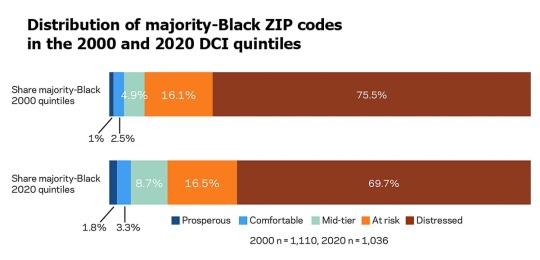
Between 2000 and 2018, the share of the U.S.’s Black population living in distressed ZIP codes dropped about 10% — from 45.6% to 35.3% — according to the report. Nationwide, 70% of majority-Black ZIP codes are distressed. By comparison, 20% of all ZIP codes and 16% of majority-white ZIP codes in the U.S. are distressed.
Of the nation’s 1,036 majority-Black ZIP codes — where 32.5% of the Black population lives — only 19 rank as prosperous on the DCI. Of those, 11 are in the Washington, DC, metro area, and two — 77545 and 77489 — are in Fort Bend County.
On average in prosperous ZIP codes, 5.2% of adults aren’t high school graduates, the poverty rate is 5.7%, 15.4% of adults are unemployed or not in the workforce, 4.7% of housing is vacant, the median household income is $90,800 and, from 2014–2018, the number of employees “in the geography” increased 20.8% while the number of businesses grew by 11.8%.
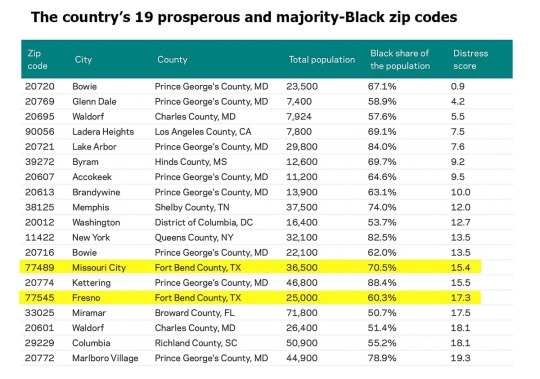
Sprawling Sun Belt cities like Houston and Phoenix, the report points out, experienced a lot of economic prosperity in the first two decades of the 21st century, but the benefits “were channeled outwards and did little to lift many chronically distressed urban neighborhoods.” Suburban ZIP codes form a ring of prosperity around the distressed core of Houston.
These include 77545 and 77489 in Fort Bend County, which as a whole has the low, low distress score of 2.3 and is one of Texas’ largest suburban counties. It’s also one of the most diverse counties in the nation. Between 2000 and 2019, the county population went from 62% white to 31%.
The population of the 77489 ZIP code in Missouri City, which has a DCI score of 15.5, is 70.5% Black or African American. The median household income is $66,400 and about 60% of residents are employed in management and professional or sales and office jobs. In 2000, the “distress score” of Missouri City’s 77489 ZIP code was 9.6, also in the prosperous quintile.
Fresno has a DCI of 17.2 and 60.3% of residents are Black or African American. Fresno’s “distress score” has improved significantly since 2000, when it had a DCI of 45.9, which is the mid-tier category of economic well-being. Most residents work in management and professional, sales and office or service industry jobs, and the median household income is $79,900.
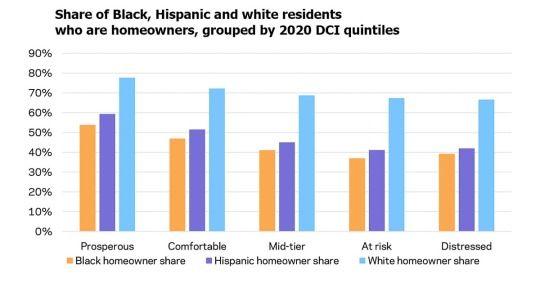
But even within prosperous communities, there’s a gap in the average median household income between Black and white households, and it has widened in the past 20 years, from $4,987 in 2000 to $6,832 in 2018.
There’s also a gap in homeownership in prosperous communities, where the percentage of Black residents who are homeowners is 53.8%, compared to 77.7% of white residents. The gaps in household income and homeownership exist across all five DCI quintiles.
Today, 27% of Fresno residents and 23.7% of those in 77489 who are 18 and older have a bachelor’s degree or higher. That’s far lower compared to all prosperous zip codes in the nation — 47.2% of residents hold a bachelor’s degree or higher. However, among Black residents of Fresno, 37.7% have a bachelor’s degree or higher. In Missouri City’s 77489 ZIP code, that’s true for 28.8% of Black residents.
In November, voters in Fort Bend County elected Eric Fagan sheriff, the county’s first Black sheriff since the Reconstruction era. Walter Moses Burton was elected sheriff in Fort Bend County in 1869. He was the nation’s first Black elected sheriff. Walter Moses Burton Elementary School — one of the three elementary schools in Fresno — is named for Burton. The other two are named for Rosa Parks and Lula Belle Goodman, an African American educator who taught in the Fort Bend Independent School District for 41 years.
#There are only 19 prosperous majority-Black ZIP codes in the US. The Houston area is home to two#Redlining#real estate disparity#home ownership disparities
5 notes
·
View notes
Text
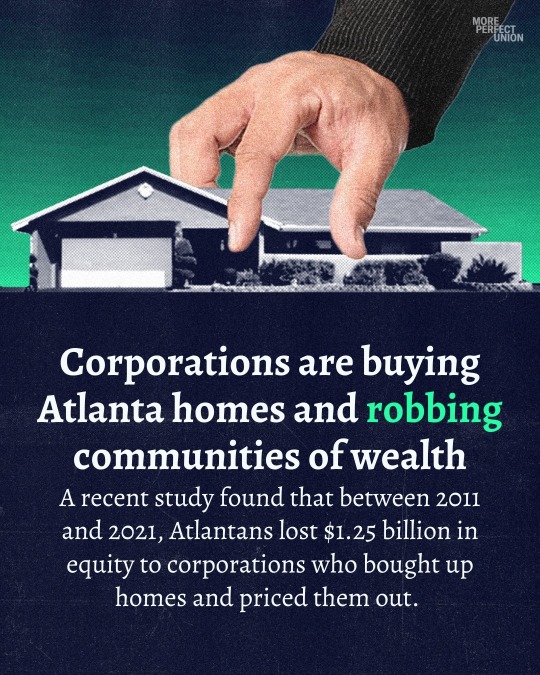
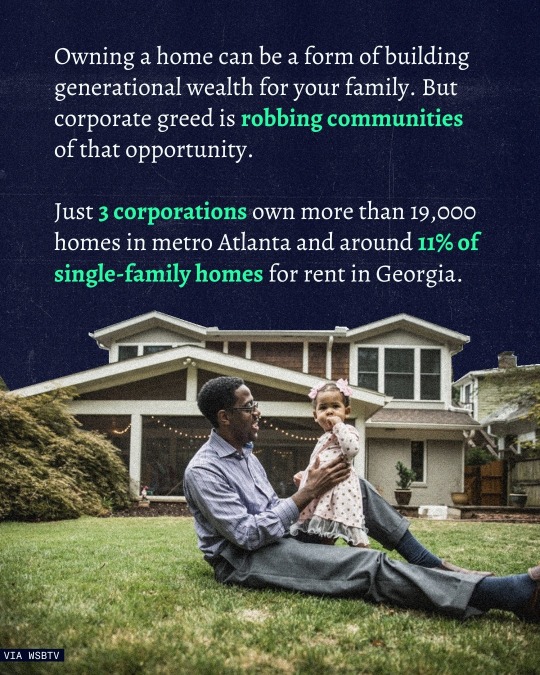
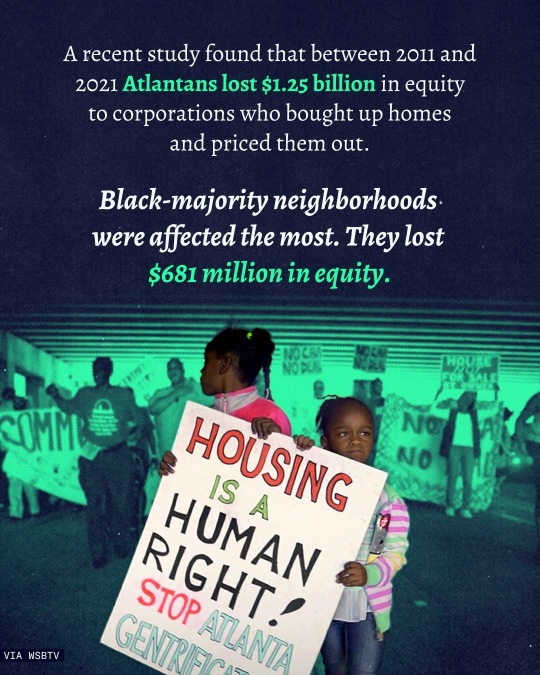

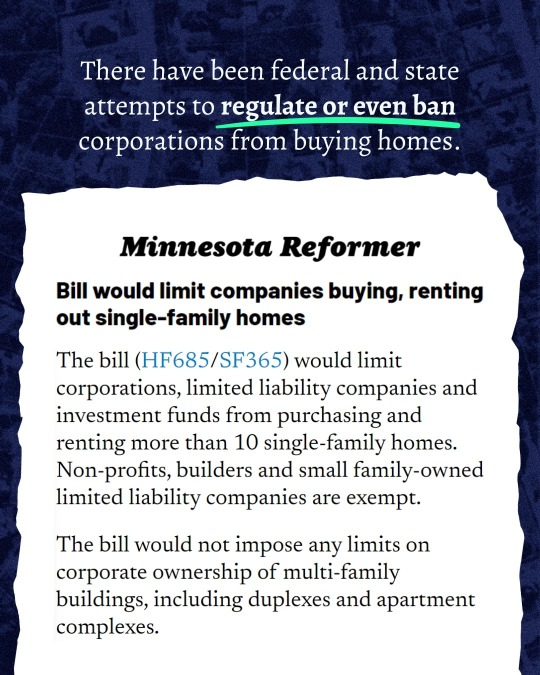
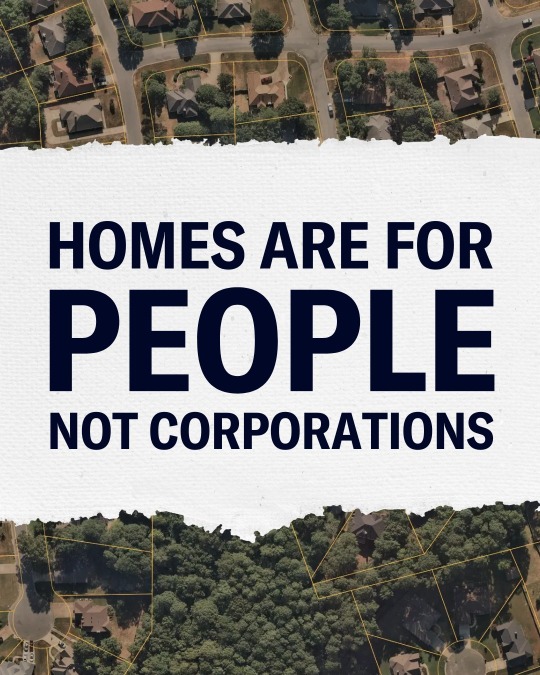
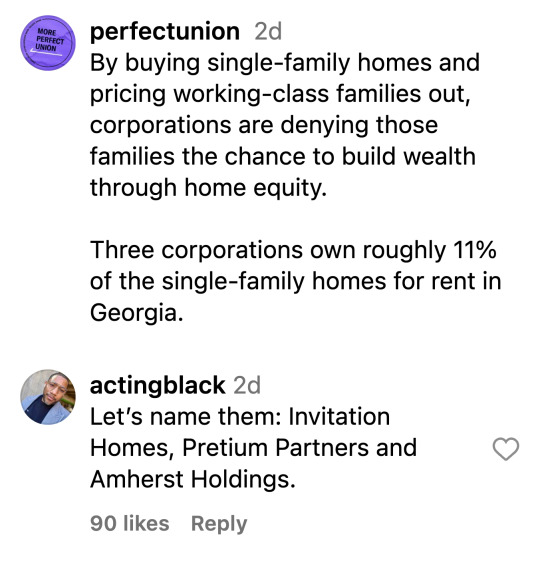

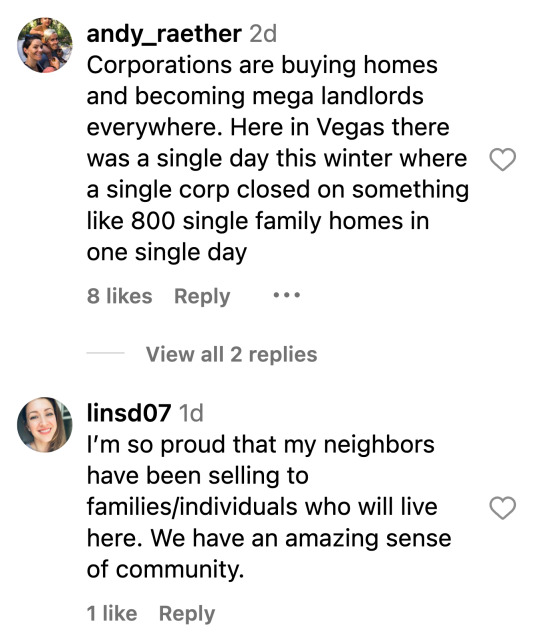
#housing inequality#corporate ownership#home equity#affordable housing#real estate market#wealth disparity#housing crisis#single-family homes#working-class families#corporate landlords#Georgia housing market#property investment#economic disparity#housing affordability#rental market#housing market inequality#corporate real estate#wealth gap#homeownership barriers#housing investment#financial disparity#real estate monopoly#housing affordability crisis#rental housing#economic inequality#property ownership#housing accessibility#corporate influence#affordable homeownership#investment firms in real estate
1K notes
·
View notes
Text
The tax sharks are back and they’re coming for your home

I'm touring my new, nationally bestselling novel The Bezzle! Catch me TODAY (Apr 27) in MARIN COUNTY, then Winnipeg (May 2), Calgary (May 3), Vancouver (May 4), and beyond!

One of my weirder and more rewarding hobbies is collecting definitions of "conservativism," and one of the jewels of that collection comes from Corey Robin's must-read book The Reactionary Mind:
https://en.wikipedia.org/wiki/The_Reactionary_Mind
Robin's definition of conservativism has enormous explanatory power and I'm always finding fresh ways in which it clarifies my understand of events in the world: a conservative is someone who believes that a minority of people were born to rule, and that everyone else was born to follow their rules, and that the world is in harmony when the born rulers are in charge.
This definition unifies the otherwise very odd grab-bag of ideologies that we identify with conservativism: a Christian Dominionist believes in the rule of Christians over others; a "men's rights advocate" thinks men should rule over women; a US imperialist thinks America should rule over the world; a white nationalist thinks white people should rule over racialized people; a libertarian believes in bosses dominating workers and a Hindu nationalist believes in Hindu domination over Muslims.
These people all disagree about who should be in charge, but they all agree that some people are ordained to rule, and that any "artificial" attempt to overturn the "natural" order throws society into chaos. This is the entire basis of the panic over DEI, and the brainless reflex to blame the Francis Scott Key bridge disaster on the possibility that someone had been unjustly promoted to ship's captain due to their membership in a disfavored racial group or gender.
This definition is also useful because it cleanly cleaves progressives from conservatives. If conservatives think there's a natural order in which the few dominate the many, progressivism is a belief in pluralism and inclusion, the idea that disparate perspectives and experiences all have something to contribute to society. Progressives see a world in which only a small number of people rise to public life, rarified professions, and cultural prominence and assume that this is terrible waste of the talents and contributions of people whose accidents of birth keep them from participating in the same way.
This is why progressives are committed to class mobility, broad access to education, and active programs to bring traditionally underrepresented groups into arenas that once excluded them. The "some are born to rule, and most to be ruled over" conservative credo rejects this as not just wrong, but dangerous, the kind of thing that leads to bridges being demolished by cargo ships.
The progressive reforms from the New Deal until the Reagan revolution were a series of efforts to broaden participation in every part of society by successively broader groups of people. A movement that started with inclusive housing and education for white men and votes for white women grew to encompass universal suffrage, racial struggles for equality, workplace protections for a widening group of people, rights for people with disabilities, truth and reconciliation with indigenous people and so on.
The conservative project of the past 40 years has been to reverse this: to return the great majority of us to the status of desperate, forelock-tugging plebs who know our places. Hence the return of child labor, the tradwife movement, and of course the attacks on labor unions and voting rights:
https://pluralistic.net/2022/11/06/the-end-of-the-road-to-serfdom/
Arguably the most potent symbol of this struggle is the fight over homes. The New Deal offered (some) working people a twofold path to prosperity: subsidized home-ownership and strong labor protections. This insulated (mostly white) workers from the two most potent threats to working peoples' lives and wellbeing: the cruel boss and the greedy landlord.
But the neoliberal era dispensed with labor rights, leaving the descendants of those lucky workers with just one tool for securing their American dream: home-ownership. As wages stagnated, your home – so essential to your ability to simply live – became your most important asset first, and a home second. So long as property values rose – and property taxes didn't – your home could be the backstop for debt-fueled consumption that filled the gap left by stagnating wages. Liquidating your family home might someday provide for your retirement, your kids' college loans and your emergency medical bills.
For conservatives who want to restore Gilded Age class rule, this was a very canny move. It pitted lucky workers with homes against their unlucky brethren – the more housing supply there was, the less your house was worth. The more protections tenants had, the less your house was worth. The more equitably municipal services (like schools) were distributed, the less your house was worth:
https://pluralistic.net/2021/06/06/the-rents-too-damned-high/
And now that the long game is over, they're coming for your house. It started with the foreclosure epidemic after the 2008 financial crisis, first under GW Bush, but then in earnest under Obama, who accepted the advice of his Treasury Secretary Timothy Geithner, who insisted that homeowners should be liquidated to "foam the runways" for the crashing banks:
https://pluralistic.net/2023/03/06/personnel-are-policy/#janice-eberly
Then there are scams like "We Buy Ugly Houses," a nationwide mass-fraud outfit that steals houses out from under elderly, vulnerable and desperate people:
https://pluralistic.net/2023/05/11/ugly-houses-ugly-truth/#homevestor
The more we lose our houses, the more single-family homes Wall Street gets to snap up and convert into slum properties, aslosh with a toxic stew of black mold, junk fees and eviction threats:
https://pluralistic.net/2022/02/08/wall-street-landlords/#the-new-slumlords
Now there's a new way for finance barons the steal our houses out from under us – or rather, a very old way that had lain dormant since the last time child labor was legal – "tax lien investing."
Across the country, counties and cities have programs that allow investment funds to buy up overdue tax-bills from homeowners in financial hardship. These "investors" are entitled to be paid the missing property taxes, and if the homeowner can't afford to make that payment, the "investor" gets to kick them out of their homes and take possession of them, for a tiny fraction of their value.
As Andrew Kahrl writes for The American Prospect, tax lien investing was common in the 19th century, until the fundamental ugliness of the business made it unattractive even to the robber barons of the day:
https://prospect.org/economy/2024-04-26-investing-in-distress-tax-liens/
The "tax sharks" of Chicago and New York were deemed "too merciless" by their peers. One exec who got out of the business compared it to "picking pennies off a dead man’s eyes." The very idea of outsourcing municipal tax collection to merciless debt-hounds fell aroused public ire.
Today – as the conservative project to restore the "natural" order of the ruled and the ruled-over builds momentum – tax lien investing is attracting some of America's most rapacious investors – and they're making a killing. In Chicago, Alden Capital just spent a measly $1.75m to acquire the tax liens on 600 family homes in Cook County. They now get to charge escalating fees and penalties and usurious interest to those unlucky homeowners. Any homeowner that can't pay loses their home.
The first targets for tax-lien investing are the people who were the last people to benefit from the New Deal and its successors: Black and Latino families, elderly and disabled people and others who got the smallest share of America's experiment in shared prosperity are the first to lose the small slice of the American dream that they were grudgingly given.
This is the very definition of "structural racism." Redlining meant that families of color were shut out of the federal loan guarantees that benefited white workers. Rather than building intergenerational wealth, these families were forced to rent (building some other family's intergenerational wealth), and had a harder time saving for downpayments. That meant that they went into homeownership with "nontraditional" or "nonconforming" mortgages with higher interest rates and penalties, which made them more vulnerable to economic volatility, and thus more likely to fall behind on their taxes. Now that they're delinquent on their property taxes, they're in hock to a private equity fund that's charging them even more to live in their family home, and the second they fail to pay, they'll be evicted, rendered homeless and dispossessed of all the equity they built in their (former) home.
It's very on-brand for Alden Capital to be destroying the lives of Chicagoans. Alden is most notorious for buying up and destroying America's most beloved newspapers. It was Alden who bought up the Chicago Tribune, gutted its workforce, sold off its iconic downtown tower, and moved its few remaining reporters to an outer suburban, windowless brick building "the size of a Chipotle":
https://pluralistic.net/2021/10/16/sociopathic-monsters/#all-the-news-thats-fit-to-print
Before the ghastly hotel baroness Leona Helmsley went to prison for tax evasion, she famously said, "We don't pay taxes; only the little people pay taxes." Helmsley wasn't wrong – she was just a little ahead of schedule. As Propublica's IRS Files taught us, America's 400 richest people pay less tax than you do:
https://pluralistic.net/2022/04/13/for-the-little-people/#leona-helmsley-2022
When billionaires don't pay their taxes, they get to buy sports franchises. When poor people don't pay their taxes, billionaires get to steal their houses after paying the local government an insultingly small amount of money.
It's all going according to plan. We weren't meant to have houses, or job security, or retirement funds. We weren't meant to go to university, or even high school, and our kids were always supposed to be in harness at a local meat-packer or fast food kitchen, not wasting time with their high school chess club or sports team. They don't need high school: that's for the people who were born to rule. They – we – were meant to be ruled over.

If you'd like an essay-formatted version of this post to read or share, here's a link to it on pluralistic.net, my surveillance-free, ad-free, tracker-free blog:
https://pluralistic.net/2024/04/26/taxes-are-for-the-little-people/#alden-capital
#pluralistic#chicago#illinois#alden capital#the rents too damned high#debt#immiseration#chicago tribune#private equity#vulture capital#cook county#liens#tax evasion#taxes are for the little people#tax lien certificates#tax sharks#race#racial capitalism#predatory lending
382 notes
·
View notes
Text
There was so much to love and scream about in today's episode of Blue Canvas of Youthful Days, but because I'm me I am going to focus on Qin Xiao's words in my favorite scene:
Just sitting here makes me feel like, whether its people from my neighborhood or people from yours, everyone takes a walk here. Everyone enjoys the same mist, same smell, same colors. It's moments like these that make me feel I am also the owner of this city. This is my home, too.
Translation approved by @thisonelikesaliens.
The sound I made when Qin Xiao said this was undignified. And I loved it for a lot of reasons. First, Qi Lu was talking about how their age gap is not that big, and Qin Xiao's mind immediately went to the gap between them that weighs most on him: their wealth and class disparity. It's something he can never forget. Second, now that he's accepted his feelings for Qi Lu, Qin Xiao is looking for the ways they are the same rather than insisting on their differences. He wants to have shared experiences with Qi Lu, and to believe that they can connect, even if it's through simple things. And third, Qin Xiao is claiming ownership of his town, and his life, in a quietly defiant way.
When you're poor and left behind in the way Qin Xiao is, you can grow up feeling like nothing truly belongs to you. You're constantly under threat of the things you hold dear being taken, either by debt collectors or those who want to prey on your vulnerability or even just by virtue of those around you having more privilege and access to the things you want. He is fighting every day just to have access to the kind of basic opportunities Qi Lu takes for granted, and he can't slip up or the consequences for his life will be huge. People with wealth and privilege just straight up don't have to think about this stuff; they walk around with an easy confidence that they belong everywhere, that they can command any space, that the world is theirs for the taking and that they will be fine regardless of their effort. We saw Qi Lu himself display some of this attitude when he entered the art school; despite his experiences of abuse, he wears that privilege like armor, and it's a kind of protection Qin Xiao will never have access to.
On top of his awareness of this difference between him and people like Qi Lu and his family, Qin Xiao also has the local gang breathing down his neck, trying to force him into sketchy work he doesn't want to do. And they can do this because they know he's so vulnerable; the gang leader is just waiting to catch him in a moment of desperation or despair so he can prey on his weakness and drag him down into the pit with him. Qin Xiao is constantly on guard from all of these people who think they own this town and can force him into their idea of his place in it.
So to hear Qin Xiao reject that, to say clearly: this is my home, too, and I get to decide my place in it and what I will do and who I will love, was so moving. For Qin Xiao to recognize that even if he doesn't have the same privilege and power as others around him, including Qi Lu, he walks these same streets and lives his life alongside them and gets to own it, too, is powerful.
#this show is about to enter my pantheon of all timers i am so serious#blue canvas of youthful days#chinese bl#shan shouts into the void
52 notes
·
View notes
Note
› HERE ME OUT, needy cat albedo, with soft kitty ears and everything.. I can imagine him giving subtle hints, slowly rubbing off on you, rubbing his scent on you.. just leaving hints.. and claiming his territory, and yet the MC doesn't realize his affections, so.. he starts taking a more obvious approach, lightly dragging his fangs on the plush skin of your neck, biting down to hold you in place..
— 🍬
P.S. I have a thing for fangs
JEGDKSKEKE CATBOY ALBEDO IS SO CUTE HE WOULD BE SO SO FLUFFY AND GAAAAH
reader is gn, albedo calls reader "master" and "mate"
TAGS = @edenialucas, @huboi, @nejibot, @yumixxn, @teallapril

It’s been a couple months since you’ve adopted this catboy. He’s an intelligent one, considerate and efficient too and you understand why Rhinedottir favoured this little guy among his litter. Alas, she had to hand over her ownership of Albedo to you. Something about her finding a breakthrough in her work and being unable to care of him any longer. When she brought the persian cat to your house, claiming you were most suited to care for him, you were beyond delighted. Rhine knows of your love for cats, catboys especially. But you never found the time to adopt one yourself. Now, you get a cute little diligent catboy to accompany your lonesome days; a change you are more than happy about!
Despite his faithful obedience to you, it took some time for him to warm up to your presence. He would listen to you if you ordered him to do your chores but he would never seek you out otherwise. Slowly, you witnessed him change. In his cat form, he lets you comb his soft fur, bathe him in warm water — surprisingly, he’s contented by water rather than aversed by it — and even sleeps beside you.
He’s adorable, so cute and precious! Everyday, he greets you home by waiting by your doorstop, meowing and rubbing his fluffy little body against your legs and you can’t help but pick him up and nuzzle his cute little face against yours. Ah, thank you dearest Rhine for choosing you. If it weren’t for her, you wouldn’t be able to experience this persian cat climbing onto you lap while you’re reading, and curling on said lap before peacefully drifting off to sleep. You wouldn’t been able to experience picking up his fluffy body, kissing all over him and witnessing the kitty bashfully look away, mewing as you shower him with affection. However, this is only when he is in his cat form. In his human form, well, he’s fine just that…sometimes you don’t know how to act.
When he’s done with chores, he would often sit beside you, watching you work while his teal eyes observes you. When watching a movie, sometimes he would shift out of his cat form and drape his arms around you, nuzzling against your cheek. Your attention would go to his flitting tail and you would stroke his soft ears as he purrs. You’re a bit taken aback by his disparate demeanour; knowing him from Rhine’s description as an aloof and independent catboy. You never expected him to have a clingy side. Nonetheless, you like it so you never called him out on it. Until today, when Albedo corners you and pins you to the bed.
“Albedo, what are you—” You gasp at the feeling of Albedo’s fangs dragging down your neck. He bites down the plush skin; not enough to puncture, but enough to make you feel increasingly alert of his presence.
“I’ve been waiting for you, but it appears that my attempts at courting you have gone unnoticed,” he says in a troubled tone, his bottom lip jutting out as he pouts. “So I’ll say this clearly: Master, I’m attracted to you. I want to be your mate.”
Teal eyes study your form, watching your eyes dart around before finding the courage to settle on him again.
“I’m…sorry for not noticing, Albedo. I assure you, I do feel the same way, I just…didn’t think you would me as anything more than a master,” you laugh sheepishly.
Albedo heaves a sigh, seemingly both out of relief and disbelief. “I see. I’m…happy that you feel the same way. To be honest, I was expecting to be rejected given your lack of acknowledgment, but now I’m glad I took the risk.” Strangely, the catboy doesn’t get off you. Before you could point it out, you squirm at the sensation of a pair of fangs nipping at another part of your neck. “Since we share the same feelings, I take it that I can take you for myself, right?”

#🍬 anon#genshin impact x reader#genshin x reader#albedo x reader#genshin albedo x reader#genshin albedo#albedo#catboy albedo#gn reader
360 notes
·
View notes
Text
State-Sponsored Discrimination
Discrimination and subjugation of specific groups by a state can manifest in various ways. Here are some common actions and policies that states may employ when engaging in discrimination or subjugation:
Legal Discrimination: States may enact laws that explicitly discriminate against certain groups, such as racial segregation, discriminatory voting laws, or restrictions on property ownership.
Institutionalized Bias: Discrimination can be institutionalized through biased law enforcement, unequal access to education, or disparities in healthcare.
Segregation: Establishing segregated facilities or neighborhoods, often along racial lines, is a classic form of discrimination.
Violence and Repression: States may use violence, harassment, or intimidation to subdue or control specific groups.
Forced Relocation: Displacing particular communities or groups from their homes or land.
Censorship and Suppression of Information: Controlling or censoring information to limit awareness and organization among discriminated groups.
Economic Exploitation: Exploiting certain groups economically by providing unfair labor conditions or limited economic opportunities.
Denial of Basic Rights: Depriving specific groups of their rights, including the right to vote, work, or access education.
Hate Speech and Propaganda: Promoting hate speech, propaganda, or stereotypes to justify discrimination.
Ethnic Cleansing and Genocide: Extreme cases involve ethnic cleansing and genocide, where the state actively seeks to eliminate a particular ethnic or social group.
Religious Persecution: Discrimination based on religion, including restrictions on religious practices, places of worship, or religious attire.
Sexual Orientation Discrimination: Enforcing discriminatory laws or practices against individuals based on their sexual orientation.
Political Oppression: Targeting groups based on their political beliefs or affiliations, including suppression of opposition parties.
State-Sponsored Discrimination: In some instances, the state sponsors and supports discriminatory groups or organizations.
Marginalization: Marginalizing certain groups from participating in the political, economic, or social life of the country.
Denial of Citizenship or Legal Status: Denying citizenship, legal status, or documentation to certain groups, rendering them stateless.
Gerrymandering: Manipulating political boundaries to dilute the voting power of specific groups.
Selective Law Enforcement: Enforcing the law selectively to target particular groups.
Mass Surveillance: Conducting extensive surveillance of specific communities or groups.
Restricted Movement: Imposing curfews, roadblocks, or travel restrictions on targeted groups.
These actions are often associated with human rights abuses, and they can result in severe social, political, and economic consequences for the affected communities. It's essential to address and combat discrimination and subjugation to ensure a more just and equitable society.
#philosophy#knowledge#learning#education#chatgpt#ethics#economics#politics#Discrimination#Human Rights#State-Sponsored#Equality#Discriminatory Policies#Social Justice#Government Actions#Inequality#Discrimination Consequences
8 notes
·
View notes
Text
Rich People Getting Richer (Part 3 of ?)
To refresh your memory, we're addressing the question of how wealthy people have a lower effective tax rate than moderate income people.
US Government policies supporting home ownership have not only lowered the effective tax rate of those wealthy enough to own a home, they have also contributed to the accumulation of wealth.
Current tax law allows for a couple to deduct the interest on a home mortgage up to $750K (for the first or SECOND home). The current Standard Deduction for a couple is $25,900 (which is greater than many people's home mortgage interest expense and other Itemized Deductions) so most couples will chose the Standard Deduction instead of choosing Itemized Deductions which can include mortgage interest.
For most of my adult life, however, the tax limit on mortgages has been greater ($1M) and the Standard Deduction much lower, so it was advantageous for most homeowners to deduct their mortgage interest. Historically, if you owned a home with a mortgage, your effective tax rate was lower than a comparable couple who rented.
Preferable tax treatment isn't the only way the US encouraged home ownership however. With a few exceptions, loose monetary policy by the Fed has allowed relatively cheap home mortgage interest rates (the current period being one of those exceptions). The US government also established quasi-government agencies Fannie Mae and Ginny Mae, and Freddy Mac to buy mortgages and issue mortgage-backed securities. Collectively, these actions lowered borrowing costs and encouraged home ownership. When you consider the additional benefit of the rise of real estate prices over the last 30 years, the result is a huge accumulation of wealth for those able to purchase a home (mostly white people).
There are good arguments that tax and monetary policies encouraging home ownership are good ideas (stable communities, wealth accumulation for the middle class, economic growth, etc.). Like any other policy however, it favors and rewards some (those who can buy a home) over others. The opportunity costs are those different policies which would have delivered economic benefits to different groups. In other words, the US has pool of economic tools which can incentivize or de-incentivize various activities and has choosen to support home ownership.
Twenty years ago I'd have objected if you said this is a racist policy. After all, the tax policy doesn't say that the home mortgage interest deduction is only available to white people. So how can it be racist?
Here's the question... is a policy racist if the benefits are inequitably distributed to a race, especially if that race is already advantaged? In the case of financially rewarding home ownership, I think you have to say yes. According to the US Treasury:
"In the second quarter of 2022, the homeownership rate for white households was 75 percent compared to 45 percent for Black households, 48 percent for Hispanic households, and 57 percent for non-Hispanic households of any other race."
The seeds of this inequity were sown with "redlining" as described in an NPR article: The redlining maps originated in the aftermath of the Great Depression, when the federal government set out to evaluate the riskiness of mortgages in major metropolitan areas of the country. The maps, created by the federal Home Owners' Loan Corporation, color-coded neighborhoods by credit worthiness. Areas with African-Americans and immigrants were almost always considered the highest risk, and they were marked in red on maps... hence, "redlining."
So follow the logic here... beginning with the redlining after the Great Depression and followed by tax and monetary policies rewarding home ownership, we now see a huge disparity in home ownership wealth. Again from the US Treasury:
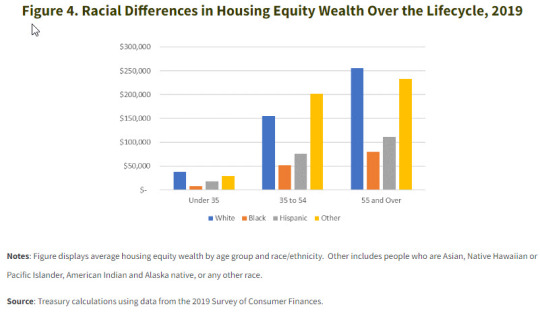
I suspect some of you may be questioning the relevance of redlining which occurred ~60 years ago. In fact, studies have confirmed the effects of redlining are still measurable today. Again from the NPR article, the study from the National Community Reinvestment Coalition, the University of Richmond and the University of Wisconsin-Milwaukee analyzed historic redlining maps from 142 urban areas across the U.S. and found "higher rates of poverty, shorter life spans and higher rates of chronic diseases including asthma, diabetes, hypertension, obesity and kidney disease."
I know I've strayed from the original question, but the reality of statistics like these are so troubling. You either have to believe that people of color don't like owning homes and accumulating wealth or the system has disadvantaged them.
I don't think this means that the government shouldn't pursue any policy that inequitably benefits a demographic which is already advantaged, but I do think it means policies should include meaningful, well-funded actions designed to actively grow the participation of the other demographics.
27 notes
·
View notes
Text
I saw Oppenheimer (here after Oppy Heim)
It is a magnificent movie. It's exciting and very interesting and thoughtfully made, and with care. I'm glad the doofus who directed the batman movies and Directing: It's Heroic (aka Inception) gets to make these very unique, fascinating, huge projects. No one else gets to these days, it feels like.
That said, I can understand some meaningful critique of the film. No, it's not at ALL condoning the actions of building nuclear weapons, but as the film states from its protagonist in a scene where he is later under close scrutiny (and to some extent bad faith interrogation) he explains that context is important. I think that is brutally true in a story about the creation and utilization of mass weapons. So what context is this film presenting?
The film is large in scope, and knows it. Characters say as much multiple times. Creating the power to unleash literal hell on earth with one "gadget" or "device" is literally world changing. It doesn't hinge entirely on the efforts of one man, J. Robert Oppenheimer, but the film takes pains to indicate that the US wouldn't have accomplished the building of the bomb on the timeline it did without Oppy's charisma, his intellect, and his ability to coordinate and collaborate with other geniuses. Oppy Heim tells a huge story, but it does brilliantly narrow the scope of the story, long ass running time aside, because it's not The Story of the Atomic Bomb it's the story of J. Robert Oppy Heim, Father of the Atomic Bomb. These are overlapping but disparate things.
I would be a hypocrite if I tossed this film aside, by the way, after I have declared more than once that The Wind Rises is Miyazaki's finest film. They are essentially parallel works, exploring very, very similar themes. That said, isn't that the crucial distinction? Miyazaki was fire bombed by the US in his own living memory. He and his family had to run away from war and violence. Now, of course, Nolan is not a man without a dark and complicated history. (Spoiler alert, we all come from pain) However, context is important, is it not? When grappling with the pain Oppy Heim inflicted, it's clear that he is at once self-flagellating, and truly guilty, filled with shame, and also unable to accept ownership of the real harm he's done at times to real people. So, when the only direct reference to real Japanese human being being charred to death, and those who survived the initial blast eventually doomed to feel their organs liquify inside their own bodies, we only see it reflected in Oppy Heim's pained face.
Which, Cilliam Murphy Deserves the Oscar, it's not even a question. That's part of what elevates the film. Really superb acting, and Cillian still the stand out.
I am not sure what to do with a film that wants to build and explore sympathizing with an accomplice to mass murder. Am I meant to see himself in him? Does Nolan, absurdly, see himself in this man? Is it just sick fascination? Is it suggesting that any of us could do this? That genius forces us to do this?
That's sort of what The Wind Rises suggests, and again, it deeply informs my reading.
So, I mean, if the film wants me to think "wow we strongly over rate Big Important Men of Genius" then sure, yes, lol.
That said, this is a film that makes a staggering case for Seeing Films In Theaters. I can't imagine seeing and enjoying this film even half as much at home on my couch with distractions abound and my wimpy sound system.
2 notes
·
View notes
Text
Do you realize what big stars real estate agents have become?
The act of ownership is all it takes to become famous.
Landlords lord more than lands.
Economy in shambles.
Avocado toasts and economic disparity. Record low wages. Record high profits. The pyramid is made of solid gold and built upon piles of bones.
Men who dwell in distant towers many hundreds of miles away from a home they own. Controlled by a subcontractor of a subcontractor and rented to no one. No pets. Could damage the cheap wood floor.
Speculations of grim cyberpunk future dystopias often depict Tokyo-style dense urban centers.
The American Cyberpunk reality is 800 lane highways. Superdense parking structures that service an apartment complex consisting only of 6,000$ a month studios.
The American Cyberpunk is global parking lot. Asphalt and concrete stretching as far as the eye can see in every direction.
There is no neon.
There is no sleek EDM music.
There are no cybernetic enhancements.
There are Tesla Cybertrucks.
There are self-driving cars incapable of telling the difference between an empty street and a human child.
There are fast food communities.
There are infinite rooms of marketable beige.
#At least Gotham has somewhat reasonable public transit#When it isn't hijacked by some asshat or another
6 notes
·
View notes
Text
https://x.com/KeneAkers/status/1701622042867740837?t=KX40ahKWIO6wPuPIyf2fnQ&s=09

The homeownership rates for different racial and ethnic groups in 2021 were as follows, based on the most recent data analyzed by NAR: -
White Americans: 72.7% -
Black Americans: 44% -
Asian Americans: 62.8% -
Hispanic Americans: 50.6%
These figures highlight the disparities in homeownership rates among different racial and ethnic groups, emphasizing the need for equitable opportunities and initiatives to address the gaps and promote equal access to homeownership for all Americans.
#redlining#generational wealth accumulation#Black wage gap#Black wealth gap#ethnic wealth gap#home ownership by race#homeownership disparities#White Lies
1 note
·
View note
Text
Rising Home Loan Costs: Examination of Typical Borrowing for Australian Homeowners
The Australian housing market is experiencing a seismic shift, as home loan costs surge to unprecedented levels. Recent data reveals that the average home loan amount for owner-occupiers has climbed to an all-time high, marking a significant change in the landscape of property ownership. In the past year alone, the average loan size for owner-occupier dwellings has increased by an alarming 8%. This rise is indicative of various factors, including rising property prices, heightened demand, and the ongoing impact of interest rate fluctuations. For first home buyers, the search for the Best First Home Buyer loans have become increasingly crucial as they grapple with these escalating costs. Many are adjusting their borrowing strategies and exploring First Home Buyer loan offers to navigate this evolving market effectively. Interestingly, while owner-occupiers feel the pinch of increased loan amounts, investors continue to dominate the real estate sector. The investor approval rate has nearly doubled that of owner-occupiers, highlighting a robust appetite for investment properties. This trend suggests that many investors are seizing the opportunity to capitalize on market dynamics, potentially viewing higher costs as a stepping stone towards greater financial returns.
For prospective homebuyers, especially first home buyers, understanding these trends is essential. The rise in average borrowing amounts underscores the importance of thorough financial planning. With interest rates fluctuating and property prices remaining high, individuals must consider their long-term financial commitments carefully. Exploring the Best First Home Buyer loans and taking advantage of First Home Buyer loan offers can significantly impact their purchasing power. Seeking advice from financial experts can help navigate these complexities and ensure that borrowers make informed decisions that align with their financial goals. The disparity between owner-occupier and investor activity raises concerns about market sustainability. The dominance of investors increases competition and price pressure, complicating the purchasing landscape for first-time buyers seeking the Best First Home Buyer loans. As investors continue to enter the market, first home buyers may find themselves outbid on desirable properties, limiting their options. To navigate this challenging environment, it’s essential for first home buyers to explore various financing options, including First Home Buyer loan offers that provide favorable terms. By staying informed and proactive, they can enhance their chances of achieving homeownership despite the competitive market. In conclusion, the current landscape of home loans in Australia reflects a complex interplay between rising costs and investor dominance. As the average owner-occupier grapples with increased borrowing amounts, it becomes vital for first home buyers to stay informed and prepared for the challenges ahead. By taking proactive steps and exploring the Best First Home Buyer loans, along with First Home Buyer loan offers, and seeking expert mortgage broker guidance and help, homebuyers can better position themselves in this competitive market. This approach enables them to strive towards achieving their homeownership dreams despite the obstacles presented by today’s financial climate.
0 notes
Text

Republican CEO's and city council members have created critical issues that have long-lasting impacts on communities. Financial segregation, especially through practices like redlining and discriminatory lending, has indeed created significant barriers for marginalized groups. These systemic inequalities have led to disparities in home ownership, access to credit, and overall economic opportunities.
Addressing these issues requires a comprehensive approach, including:
Policy Changes: Implementing and enforcing fair housing laws, anti-discrimination policies, and regulations that promote equal access to financial services.
Community Support: Providing resources and support to communities affected by these practices, such as financial education, affordable housing programs, and community development initiatives.
Increased Awareness: Raising awareness about the historical and ongoing impacts of financial segregation and advocating for systemic change.
It's a complex issue, but with concerted efforts, progress can be made towards a more equitable and just financial system.
1 note
·
View note
Photo
Image ID:
Image 1: A side-by-side chart comparing South Africa's Apartheid (Afrikaans: [aˈpartɦɛit] past tense); and Israel's Hafrada (Hebrew: [הפרדה] present tense), with Apartheid on the left and Hafrada on the right (this pattern will continue through the photoset).
Land expropriation. Apartheid: 1913 Natives Land Act. Hafrada 1950 Absentee Property Law
Racial Classification: Apartheid 1952 Pass Laws Act. Hafrada 1982 Identity Card Act
Mass Displacement: Apartheid 1960-1983 Forced Evictions. Hafrada 1948 & 1967 Forced Displacement
Violent Repression: Apartheid 1960 Sharpeville Massacre. Hafrada 2018 Great March of Return
Token Independence: Apartheid 1970-1981 South African Bantustans. Hafrada 1995-present Palestinian Authority
The following images provide more information on each point.
Image 2: A side-by-side comparison of Apartheid and Hafrada, covering point 1: Land Expropriation. On the left, there is a diagram of South Africa covered mostly in black, where the black coloring means "No Black Ownership." On the right, there is a diagram of Israel/Palestine with the southern end and parts of the west covered in black where the coloring means "Israeli 'state land' ."
Apartheid. 1913 Natives Land Act. The first of a series of laws that were designed to outlaw Black land ownership and segregate "population groups" by race.
Hafrada. 1950 Absentee Property Law. The first of a series of laws bringing the land of displaced Palestinians under Israeli state control for the benefit of Jewish-only settlement.
Image 3: A side-by-side comparison of Apartheid and Hafrada, covering point 2: Racial Classification. There are photos on both sides of the types of identification each group was forced to carry.
Apartheid. 1952 Pass Laws Act: Required all Black people in South Africa over the age of 16 to carry a "pass book" while in White areas.
Hafrada. 1982 Identity Card Act: Requires all people in Israel, West Bank, and Gaza over the age of 16 to carry an Israeli-issued ID card which can be used to identify their ethnicity.
Image 4: A side-by-side comparison of Apartheid and Hafrada, covering point 3: Mass Displacement. There are photos of ruined homes on each side. The left depicts District Six, Capetown, c. 1974. The right depicts Manishiyya neighbourhood, Jaffa, c. 1948.
Apartheid. 1960-1983 Forced Evictions: 3.5 million Black South Africans removed from their homes in order to establish residential segregation.
Hafrada. 1948 & 1967 Forced Displacement: Over 1.1 million Palestinians forcibly displaced during the 1948 Nakba ("catastrophe"} and 1967 Naksa ("setback").
Image 5: A side-by-side comparison of Apartheid and Hafrada, covering point 4: Violent Repression. On the left is a poster saying "Remember Sharpeville." There is a photo from the event, followed by "Mass meeting. Wednesday 21 SSI. 12:30." On the right is a photo of the Great March with a caption in Arabic at the top.
Apartheid. 1960 Sharpevill Massacre: 69 unarmed South Africans killed during peaceful protests against the racist "pass laws" ID system.
Hafrada. 2018 Great March of Return: 42 unarmed Palestinians killed in Gaza in one day during peaceful protests calling for end to Israeli siege and return of refugees.
Image 6: A side-by-side comparison of Apartheid and Hafrada covering segregation.
On the left is an aerial photo of South Africa showing the disparity between Bloubosrand -a White gated community, and Kya Sands -a Black township. Bloubosrand has higher quality living with clearly defined large buildings and greenery, while Kya Sands has much smaller buildings almost resembling ruins from its aerial perspective, and no visible greenery.
On the right is a photo of Israel/Palestine showing a similar disparity between Pisgat Ze'ev East -an illegal Israeli settlement, and Shuafat -a Palestinian refugee camp. The buildings in Pisgat Ze'ev are larger and flanked by trees and other greenery, while the buildings in Shuafat are crammed together and lack greenery.
Apartheid. 1. "Separateness": the state of being separate, literally "apart-hood." 2. name used to describe South Africa's state policy of segregation by race, 1948-1990.
Hafrada. 1. "Separations": the act of separating things (or people) from each other. 2. name used to describe Israel's state policy of segregation by ethnicity, 1948-present.
Image 7: A side-by-side comparison of Apartheid and Hafrada, covering point 5: Token Independence. The photo on the left depicts a map of South Africa with a few small areas toward the north and southwest colored in black. The coloring indicates Black "homeland." The photo on the right depicts a map of Israel/Palestine with a few areas in the center (West Bank) and the Gaza Strip highlighted in black. The coloring indicates Palestinian administered.
Apartheid. 1970-1981 South African Bantustans: Apartheid government defined ten fragmented Black "homelands," each run by a puppet authority.
Hafrada. 1995-present Palestinian Authority: Palestinian Authority set up in coordination with Israel to govern disconnected fragments of the West Bank and Gaza.
Underneath each image is the source for the photoset.
Sep 2018
Sources bit.ly/vp-hafrada
visualizingpalestine.org
Symbols indicating a CC BY-NC-ND 4.0 Deed: Attribution-NonCommercial-NoDerivs 4.0 International
facebook @visualizingpalestine
twitter/x @visualizingpal
Instagram @visualizing_palestine





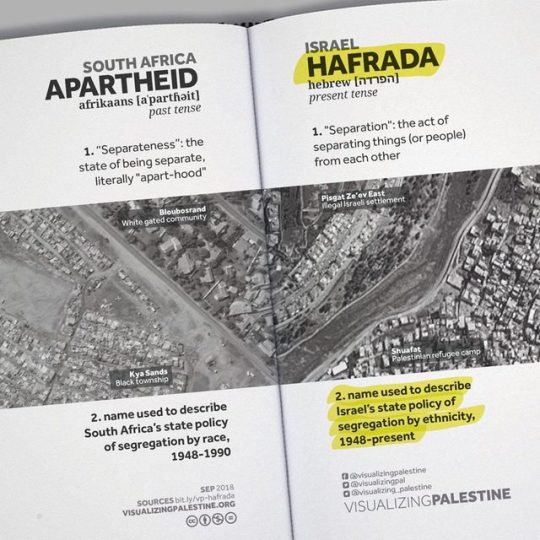

HAFRADA / APARTHEID
These five features of apartheid SouthAfrica are echoed in Israeli policies toward Palestinians today: 1. land expropriation, 2. racial classification, 3. mass displacement, 4. violent repression, and 5. token independence.
This series will be exhibited for the first time in London on Nov. 3, in partnership with the Palestine Solidarity Campaign UK, at their Justice in Palestine conference on ending Israeli apartheid. PSCJusticeConf
Download the visuals: HERE
9K notes
·
View notes
Text
HUMAN FORM (EXERCISE 3 DRAFT 2) Imagining what the Human Form would be 80 years in the future
Food Food will be personalized through smart “nutrition pods” in homes, which analyze health data and create meal capsules using nutrient-dense algae, lab-grown proteins, and tailored micronutrients. 3D food printers will produce dishes based on dietary needs, reducing food waste. Urban rooftop farms and biomes will produce seasonal vegetables and herbs, allowing for hyper-local and fresh food without the need for long-distance shipping.
Water Communities will operate on closed-loop water systems, capturing, purifying, and recycling all water within each district. Buildings will feature “dew collectors” that harvest water from the air, supplementing traditional sources. Smart sensors will analyze water quality and suggest conservation tips through community apps, ensuring every drop is used efficiently and safely.
Housing Homes will be built from regenerative materials that naturally absorb carbon dioxide. Living walls and roofs will support biodiversity by housing pollinator plants and providing nesting spaces. Community living spaces will be modular and transformable, adapting to residents’ needs over time and minimizing waste in construction. Neighborhoods will include shared gardens and social spaces that foster a sense of belonging.
Education Education will be globally accessible through immersive virtual classrooms and AI mentors that adapt to each student’s learning style. Learning will emphasize empathy, critical thinking, and collaboration with other cultures, creating a well-rounded, globally-aware population. Students will have experiential learning options like virtual field trips to historical events and hands-on labs in sciences, arts, and engineering.
Healthcare Healthcare will be deeply personalized, with AI continuously monitoring health through implanted or wearable micro-devices. Homes will have wellness capsules for preventive care, where individuals can track vitals, administer diagnostics, and even dispense treatments for minor issues. Gene therapies and nano-medicine will target diseases before symptoms appear, while mental health AI will provide ongoing support for emotional well-being.
Social Equity A focus on equity will ensure universal access to resources, with AI tools identifying and addressing systemic disparities in real-time. Community resource centers will provide free access to essential services, from legal aid to education. Basic income and shared ownership models will empower people to lead fulfilling lives without financial strain, ensuring a high quality of life for everyone.
Gender Equality Gender-neutral policies will govern workplaces, education, and healthcare, where systems automatically adapt to prevent discrimination and ensure equal access. Public life will embrace all gender identities, with AI-driven bias detection in policy-making, hiring, and healthcare to create a supportive, equitable environment.
Work & Income Work will focus on societal and environmental impact, with people choosing meaningful projects aligned with their values and talents. Automation will handle routine tasks, and flexible, short-term contracts will allow individuals to work on various projects without traditional career limitations. Basic income will provide security, and jobs will focus on creative and intellectual growth.
Energy / Electricity Energy sources will be entirely renewable, drawing from an interconnected global grid that relies on solar satellites, fusion power, and advanced wind and tidal systems. Every building will generate some power, whether through solar windows, kinetic floors, or wind-capturing facades. AI-managed grids will balance supply and demand globally, ensuring clean, constant power for all.
Peace & Justice Justice will focus on proactive solutions, with AI mediators analyzing and preventing conflicts before they escalate. Legal decisions will be guided by AI to eliminate bias, with a focus on rehabilitation and community repair. Peace will be maintained through citizen-driven councils and data-informed governance, ensuring justice that serves both individuals and society.
Transportation Transportation will be rapid, silent, and eco-friendly, with electric air taxis, maglev trains, and autonomous pods that communicate to optimize routes and reduce traffic. Walkways, bike paths, and green public transit will be woven into city layouts, reducing the need for private vehicles and encouraging low-carbon travel options.
Political Voice Blockchain voting will make democratic processes secure, with real-time community polling allowing citizens to weigh in on local and global decisions continuously. Digital transparency will hold leaders accountable, and citizens will participate in policy discussions via interactive forums, creating a fluid, engaged democracy.
Air Pollution Green technology like air-purifying trees and advanced filtration towers will neutralize urban pollutants. Smart pollution-monitoring systems will detect and address air quality issues in real-time. All vehicles and factories will run on clean energy, making urban air as pure as natural reserves.
Noise Pollution Cities will be designed to minimize noise, with sound-absorbing materials in streets, buildings, and transportation. Noise-reduction sensors will monitor and adjust sound levels in real-time, allowing for dynamic control of city noise. Nature corridors and quiet zones will provide spaces of calm within busy cities.
Non-Human Life Urban planning will prioritize habitats for non-human species, with green corridors, sky gardens, and biodiverse public spaces. AI-driven conservation initiatives will protect local ecosystems, monitor animal populations, and balance human activity with the needs of wildlife, fostering cohabitation.
Chemical Pollution Production processes will rely on sustainable, non-toxic materials, and manufacturing facilities will be carbon-neutral. Specialized filtration systems in factories will remove pollutants from water and air, while decentralized recycling will ensure efficient, eco-friendly waste management. Policies will enforce “green chemistry” standards, replacing harmful chemicals with biodegradable options.
Water Bodies & Supply Water sources will be safeguarded with advanced filtration and AI-monitored purity systems. Large-scale desalination plants, powered by renewable energy, will make ocean water a primary source of drinking water. Floating wetlands and bioengineered plants will support marine biodiversity and maintain water ecosystems' health.
Waste Management Waste will be a thing of the past as a circular economy takes hold. AI-powered sorting systems will redirect waste materials to recycling, composting, or repurposing channels, creating a closed-loop system. Biodegradable packaging and products will eliminate plastic waste, and waste-to-energy systems will provide additional renewable energy sources.
Land Use, Streets & Public Spaces Public spaces will be vibrant, with urban parks, walkable pathways, and shared green areas. Streets will prioritize pedestrian and cyclist accessibility, reducing car dependency. Public squares will host events, cultural activities, and community markets, creating hubs of social and economic engagement within neighborhoods.
Ocean Pollution Autonomous clean-up drones will patrol and cleanse oceans, capturing plastic and pollutants. Coral and marine life restoration projects will rebuild biodiversity in damaged areas, while biodegradable materials will prevent future pollution. Global cooperation will enforce ocean protection zones, fostering healthy marine ecosystems.
Effects of Climate Change Cities will adapt to climate extremes with buildings designed to withstand storms, floods, and extreme heat. Urban forests, wetlands, and green roofs will help regulate temperature and manage water flow. Reforestation and carbon capture technology will mitigate CO2 emissions, while predictive AI will help prepare for natural disasters.
Urban Agriculture & Greenification Cities will integrate agriculture into every available space, from rooftop farms and vertical gardens to community plots. Bioengineered plants will improve air quality and reduce urban temperatures, while automated irrigation systems will optimize water use. Green spaces will create a cooler, more livable environment for all.
Gender & Sexuality Gender inclusivity will be ingrained in every institution, with healthcare, education, and public spaces respecting and supporting all identities. Inclusive laws and policies will ensure that everyone can express themselves authentically without societal restrictions, creating a world of acceptance.
Diversity & Inclusion AI will ensure representation across all sectors, proactively identifying and addressing any bias or inequality. Policies will promote equal opportunity, and educational institutions will prioritize cultural, ethnic, and neurodiverse awareness, fostering communities that celebrate all identities.
Accessibility Universal design will make every environment accessible, with real-time AI assistance guiding individuals with disabilities. Public spaces, transportation, and technology will prioritize accessibility, using innovations like automated wayfinding, speech-to-text devices, and sensory-friendly environments.
Sustainability Sustainability will be a core tenet of all systems, with regenerative practices embedded in production, architecture, and daily life. Circular economy principles will guide product design, and global collaboration will drive environmental protection, creating a society that flourishes alongside the planet.
#Future of Humanity#Imagining the Future#80 Years from Now#Sustainable Future#Urban Utopia#Green Technology#Future Society#Eco-Friendly Living#Climate Adaptation#Future of Food#Renewable Energy#Urban Agriculture#AI & Society#Environmental Justice#Circular Economy#Gender Equality Future#Inclusivity in the Future#Clean Cities#Accessible Design#Smart Cities#Futuristic Housing#Biotechnology in Health#Equitable Future
0 notes
Text
10 posts!

Divorce Mediation،Choosing Between Fault and No-Fault Divorces
The dissolution of a marriage can be a deeply stressful experience, marked by heightened emotions as couples navigate critical issues such as alimony, child custody, and child support. Unfortunately, the traditional divorce process often exacerbates hostility between spouses as they face pivotal decisions about their futures. For many couples, especially those whose relationship is neither abusive nor irreparably broken, alternative approaches like mediation can be a more constructive way to resolve disputes than going through the courts.
It is a reality of modern life that not every marriage is meant to last forever. For spouses considering divorce later in life, particularly those over 50, the challenges can be unique. Divorce at this stage may have far-reaching implications on retirement plans, health care coverage, Social Security benefits, and ownership of family assets like the home. Consulting with a divorce lawyer before initiating the process can help identify potential issues and provide strategies to secure the best possible outcome.
Weighing the Decision to Hire a Lawyer
Deciding whether to hire a lawyer for a divorce involves balancing the pros and cons. If your relationship with your spouse is severely strained or if there has been abuse, legal representation is essential to protect your rights. Similarly, if your spouse has already secured a lawyer, it would be prudent to have your own attorney to ensure a fair process.
However, in cases where the couple is able to communicate and resolve key issues amicably, handling the divorce without a lawyer can result in substantial savings on legal fees. This approach is often more suitable for couples who are ending a short-term marriage, have similar incomes, and lack significant assets or children.
The Value of Legal Representation
The primary advantage of hiring a divorce lawyer lies in their ability to clarify and protect your legal rights, particularly in more complex cases. When one spouse has separate property, or the couple has significant marital assets, minor children, or substantial income disparities, having legal counsel can make a significant difference in achieving a fair and just settlement. While lawyers can sometimes increase the tension in a divorce, they also have the expertise to guide their clients through a collaborative divorce process that helps alleviate the pressure during this challenging period.
0 notes
Text
I just had some thoughts on landlords and renting, and you know what? Became a long post, so I'm saving your dash from it, especially cause you can't even reblog it cause I don't want to deal with someone 4 reblogs out wanting a debate
Read it if you want, but I'll compact it
Ok... so... clearly somewhat controversial opinion, but I don't think landlords are inherently bad, I think that many are, but I don't think it's an inherently awful thing
Like I want to make this bit clear, me? I like owning my house, and I'd like everyone to own a house, I think that should be something everyone has the chance to do. Personally I dislike renting a great deal, I'm team homeowner (and death to HOAs)
It's just... I could be wrong here, but I get the impression that not everyone always wants to own a house. That people who are in transitive times in their lives like college, or say... moving away from someone abusive, might want to be able to do something for a year or two rather than having to do full on home ownership
If I'm wrong, if no one like that exists, then sure, fuck landlords all together. I'm not that person. If I'm right though... to do that you do need someone to rent a place out, and... we call that a landlord
I just kinda feel like we maybe need to start being able to distinguish between "person that owns a couple houses and rents the spares out" vs "massive company that buys up everything and then rents them back to people for absurd rates"
Like I remember when covid first hit, there was a story about a landlord who owned a building, and before anything was passed he was already saying to his tenants "don't worry about it, pay if you can but I get what's going on right now"... he had a whole building but... sometimes there's a bit of a difference between how a single person's gonna act and how a monolithic firm is gonna act
Like I'm all for having discussions about how society is structured, how you have a bunch of the haves leasing back necessities to the have nots at crazy prices and how maybe that contributes to the huge wealth disparity we see
It's just... you know how people point out that often with "eat the rich" types they're going after people like doctors who... are comfortable, but aren't rich by any means, aren't the ones with private jets and stuff and man... this feels like another case where people can't be trusted to figure out what rich means... also where only having one word for something leaves people confused and assuming everything called that word is the same
Like I don't have huge sympathy for landlords, that whole "tip your landlord" thing is stupid. At the same time, some dude who rents out a spare house and maintains the property himself, is kinda different to me that someone who owns a whole ton of properties and just siphons off all this money while acting like they're so put upon (you know the types, you see the dumb stuff they say)
...I think I'm gonna make this not rebloggable, less cause of any of you, cause I don't want to be debating some rabid loony 4 reblogs out
This is a letter to the editor tossing out an opinion, not a debate on policy
I just kinda feel like we more need to work on figuring out how renting should be structured and stopping malicious actors from draining everyone dry, rather than saying the very concept of a landlord is evil and doing away with renting entirely (which I've seen specifically proposed, explicitly they stated that people who rent properties should be forced to do it at a loss because they wanted renting to cease)
Again, my horse in this race is fuck renting, I'd love you to all have your own home cause... fuck, I couldn't even survive if I had rent or even a mortgage (don't know what I would have done if I hadn't found this place for $90k, last affordable house in this state)
I don't like renting, I'm not sad if it goes belly up... I just... I can't help but wonder if even some of the people who say they want that would actually be happy owning a home. Surely plenty would but... again, there's a lot of upfront cost to buying (even if prices reduced a lot), and it's something that becomes a lot harder to do things like move if you find you need to
(And if the argument is that houses should just be free... lefty and pro welfare as I am, not sure if that's a good idea. Finding a way to make renting free via things like subsidies and making sure tenets are getting a fair deal I can see, and working to make home buying easier I can see, but if the plan is just to give everyone a house they own... I'm not sure that one would work out successfully in a way that leaves society better off)
Sorry, just something that's on my mind right now. Again, I do agree that fuck the vast about of landlords, cause so much of the US for instance has basically been bought up by a handful of companies and renting is insane
I just worry about all or nothing mentalities where the very concept of someone renting something to someone else starts to become a vile idea
Like I'd be more or less ok with that... I just... wonder if everyone else who wants it has thought it through enough
0 notes